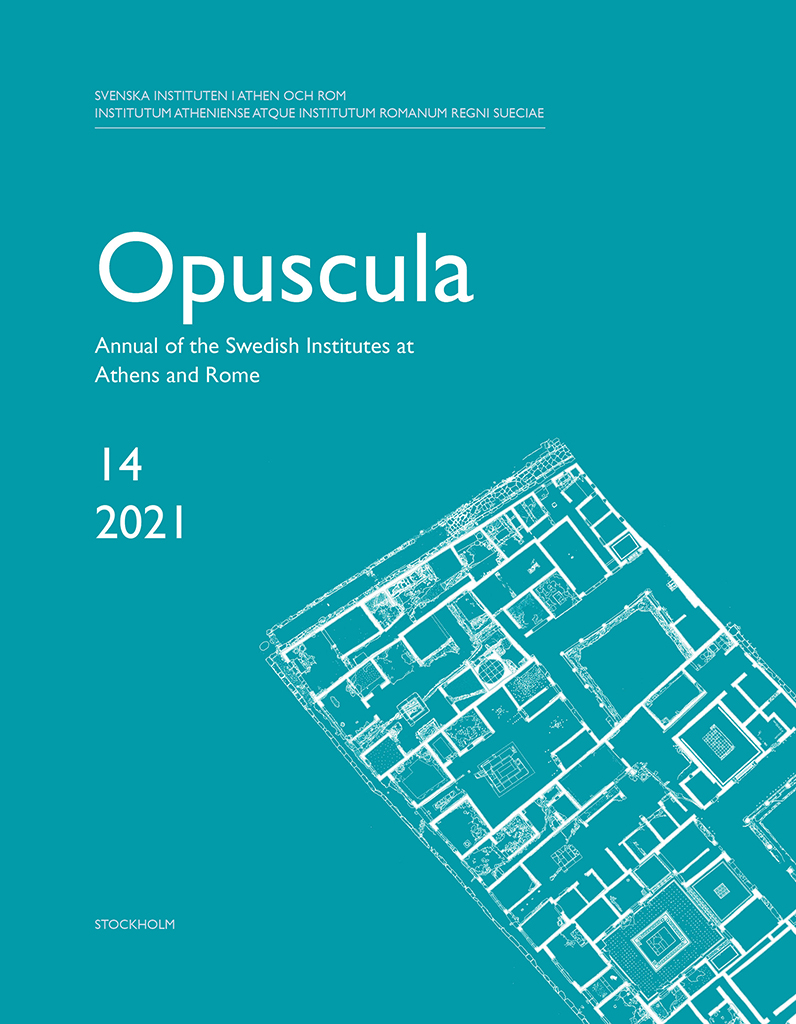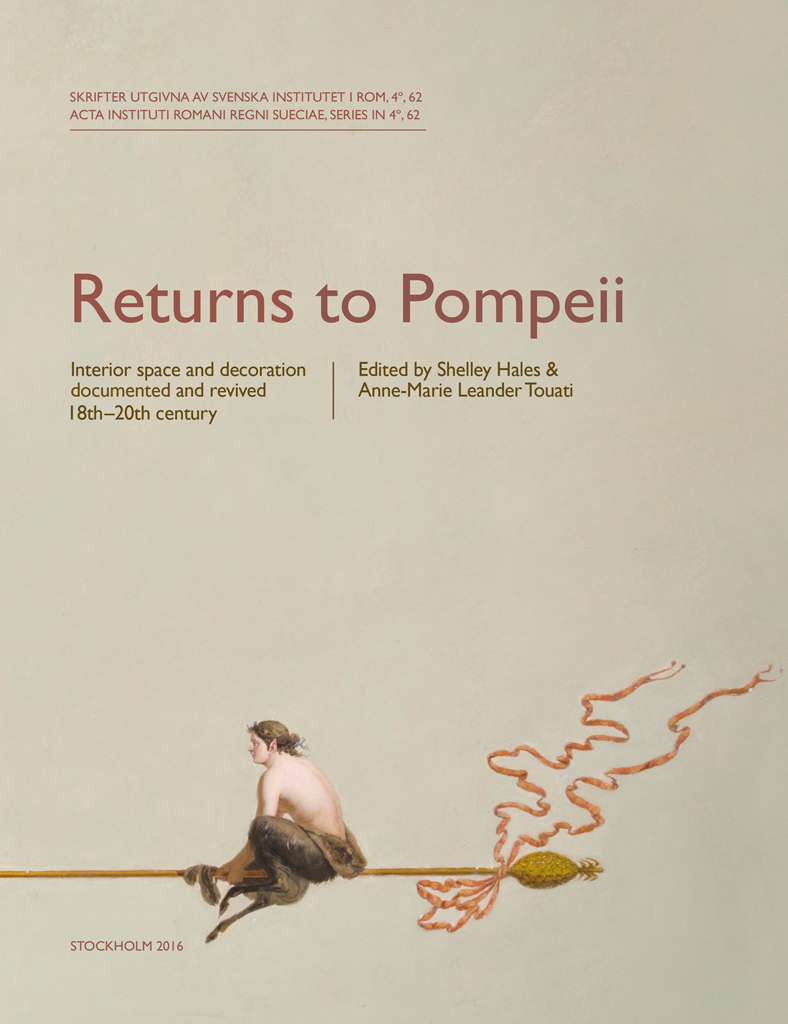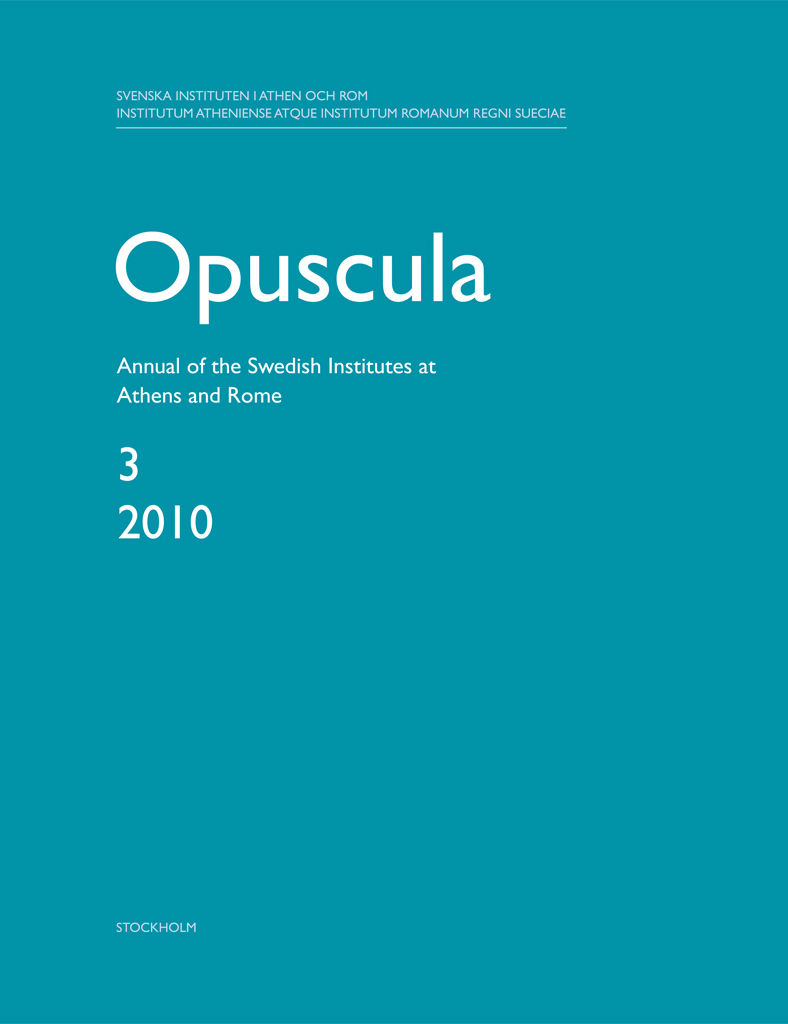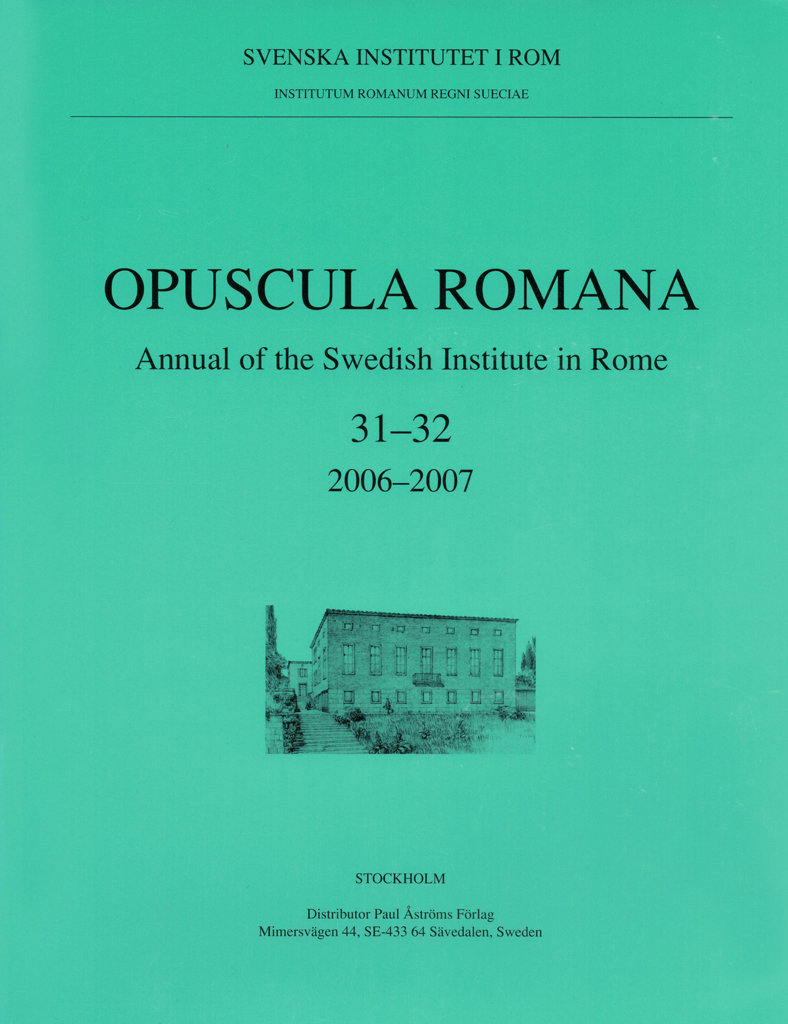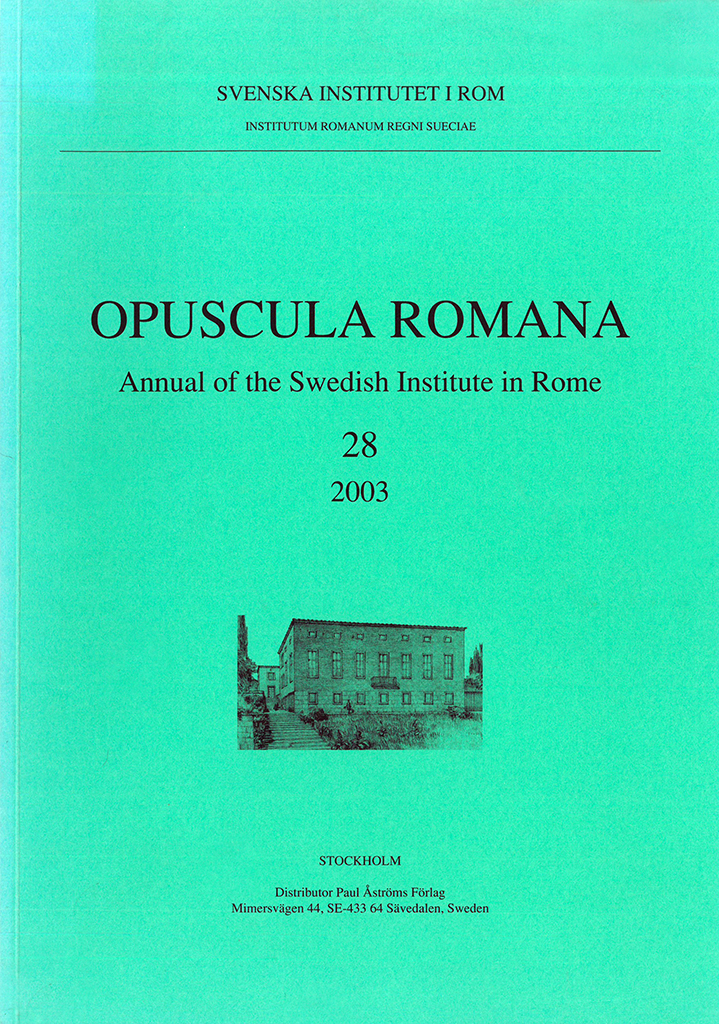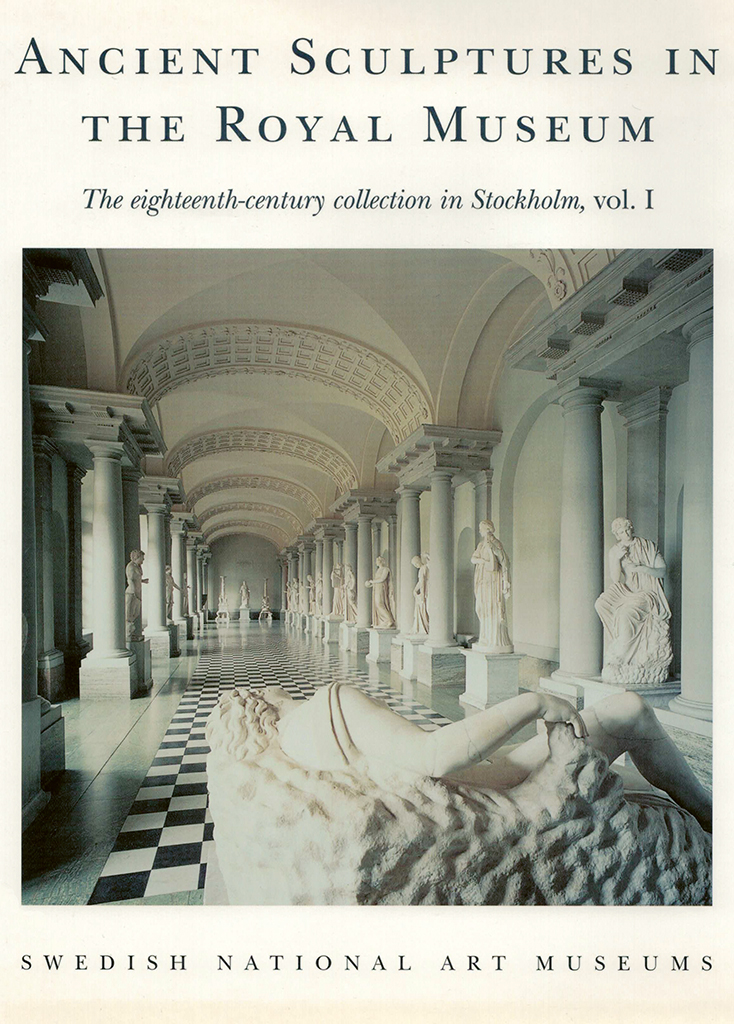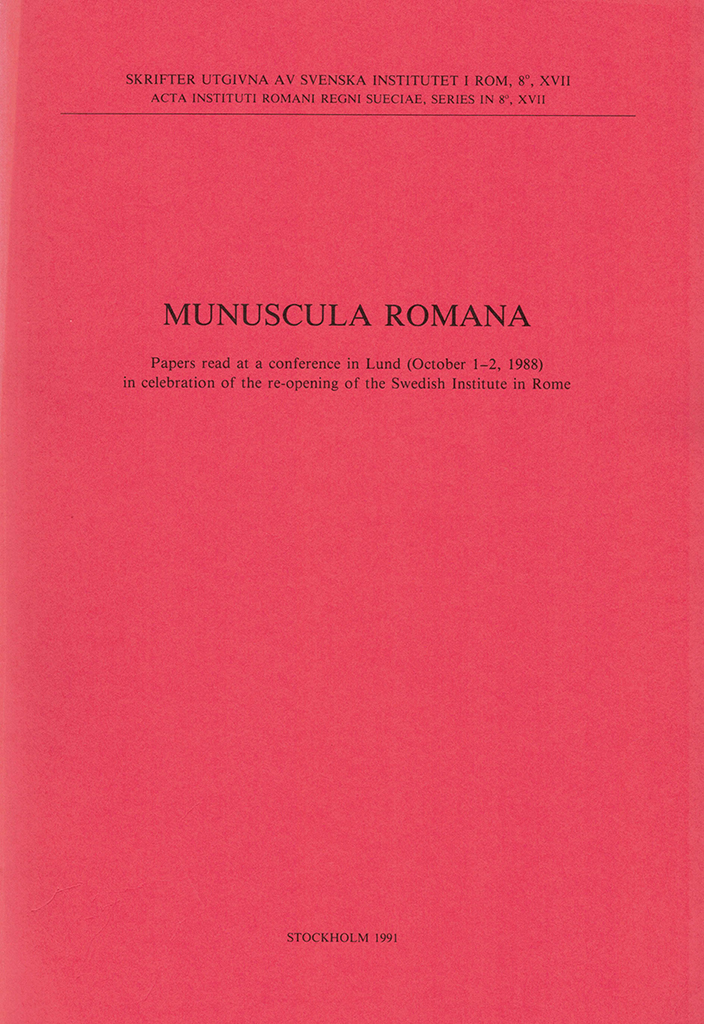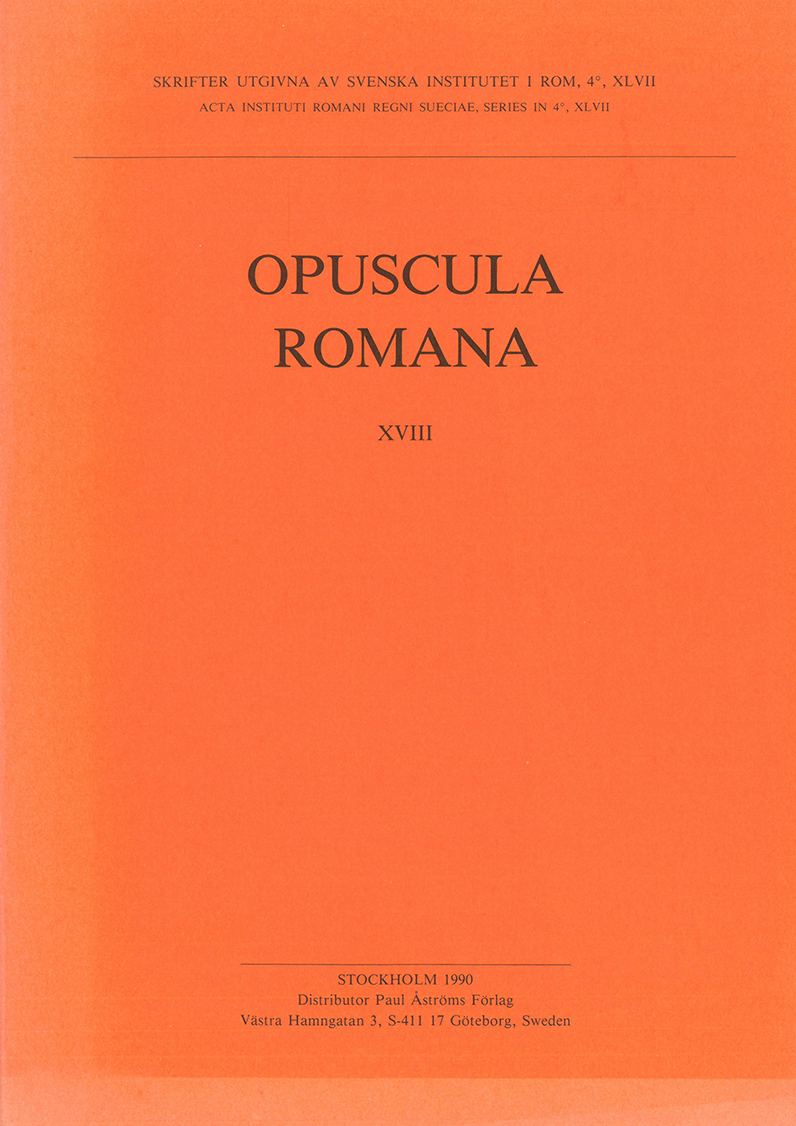Opuscula is published by the Swedish Institutes at Athens and Rome, with the aid of a grant from the Swedish Research Council. Distributed by Eddy.se AB. View journal at ERIH PLUS. All content available with open access. Building the social. A query into the societal impact of the Pompeian water supply By Anne-Marie Leander Touati (Lund University) Abstract This study explores the importance of the means of ensuring water supply in the formation of the architectural profile and basic social organization of Pompeii. It sees the city’s domestic water supply, for over two centuries ensured through rainwater-harvesting areas, basins and cisterns situated mainly in and below the many atria, as a stabilizing factor of both cityscape and household. Through the introduction of the city aqueduct in the 1st century AD and the creation of a generous network of public fountains this situation changes and the need to maintain the traditional organization of the “houseful”, comprising enlarged family, slaves and dependents of various kind including shopkeepers, is lessened; the physical proximity between those of different status renegotiated. This development, witnessed in adaptations of the architecture, can be followed through close study of the standing structures in Insula V 1. The hallmarks are…
Opuscula is published by the Swedish Institutes at Athens and Rome, with the aid of a grant from the Swedish Research Council. Distributed by Eddy.se AB. View journal at ERIH PLUS. All content available with open access. From 2D and 3D documentation to 4D interpretation. Building archaeological conclusions and workflow strategies gained by remote study of Insula V 1, Pompeii By Anne-Marie Leander Touati (Lund University, Sweden), Thomas Staub (Lund University, Sweden) & Renée Forsell (Lund University, Sweden) Abstract The text describes new methods elaborated for and used in the building archaeological assessment of a city block, studied first on site, then remotely by members of the Swedish Pompeii Project. Use of a digital platform, with collected wall observations and analysis, systematic photographic documentation of all standing structures, and 3D models, allowed discussion to proceed after the fieldwork came to an end. The models provided new possibilities and new angles of approach, e.g. examining walls at any given point, studying boundary walls as wall-strings in their full extent, allowing all kinds of sectioning at will, introducing bird’s-eye views as a new perspective in study, and measuring wherever needed. The joint results obtained are summed up in a four-phase development of the…
Published by the Swedish Institute of Classical Studies in Rome. Distributed by Eddy.se AB. Returns to Pompeii. Interior space and decoration documented and revived. 18th–20th century Edited by Shelley Hales & Anne-Marie Leander Touati Abstract This volume presents a series of case studies that trace the ways in which audiences across Europe have attempted to return to Pompeii by emulating its interior decorations since the city’s rediscovery in the mid-eighteenth century. As such, it is about both the impact of Pompeian antiquity on the present and the reception in the present of that antique past, exploring the variety of ways in which Pompeian domestic space and decoration have been revived (and for what purposes and audiences). The contributions to the volumes compare the ways in which Pompeian wall decorations were interpreted and adapted, given new context and put to serve new social and political purposes, both close to their place of discovery, in the Kingdom of Naples, and in the far-off European periphery, represented by Denmark and Sweden. The many images presented to the reader in this volume confirm colour, fantasy and playfulness, alongside an almost academic orthodoxy of structure, as trademarks of a defined neo-Pompeian style. The volume brings…
Opuscula is published by the Swedish Institutes at Athens and Rome, with the aid of a grant from the Swedish Research Council. Distributed by Eddy.se AB. View journal at ERIH PLUS. Content available with open access. Water, well-being and social complexity in Insula V 1. A Pompeian city block revisited By Anne-Marie Leander Touati Abstract Swedish archaeologists have been working in Pompeii since 2000. Our fieldwork has consisted mainly of the study of standing walls and cleared floor levels in a city block unearthed in the 19th century and of the production of a comprehensive documentation, presented in an open access publication: www.pompejiprojektet.se/insula.php. The perspective of the present paper is the insula as a whole. Its main study objects are features of recurrent nature that in varying form and frequency are found in many of the separate houses and other units that constitute this insula: for example, the divergent materials used for the rubble masonry in the first phase of urbanisation, structures used for water management such as water supply and drains, possible earthquake damage and resulting repairs, preferences for where kitchens and sanitary installations are placed, markers indicating property borders and dependencies such as pavement curbing, courses of water…
Published by the Swedish Institute of Classical Studies in Rome. Distributed by Eddy.se AB. Opuscula Romana. Annual of the Swedish Institute in Rome 31–32, 2006–2007 Contents Johnny R. Bengtsson | Late Bronze Age handles from the Apennine settlement at Luni sul Mignone: Some chronological observations Ingela M.B. Wiman & Yvonne Backe-Forsberg | Surfacing deities in later Etruscan art and the sacellum at San Giovenale Allan Klynne | The Villa Selvasecca revisited John W. Hayes | Villa Selvasecca: the pottery finds Ebba Engström & Ragnar Hedlund | Villa Selvasecca: the coins Dominic Ingemark | Villa Selvasecca: the glass Anne-Marie Leander Touati | Interim report of the Swedish Pompeii Project: Work 2000–2004/5 in Insula V 1. Introduction Margareta Staub Gierow | The House of the Greek Epigrams V 1,18.11–12: preliminary report 2000–2004 Arja Karivieri & Renée Forsell | The House of Caecilius Iucundus, V 1,22–27: a preliminary report Henrik Boman & Monica Nilsson | The commercial establishments V 1,13; V 1, 14–16; V 1,20–21: preliminary report 2001–2004 Mark Robinson | Evidence for garden cultivation and the use of bedding-out plants in the peristyle garden of the House of the Greek Epigrams (V 1, 18i) at Pompeii Henrik Boman & Monica Nilsson |…
Published by the Swedish Institute of Classical Studies in Rome. Distributed by Astrom Editions. Opuscula Romana. Annual of the Swedish Institute in Rome 30, 2005 Contents Anne-Marie Leander Touati | The Piranesi marbles from Rome to Stockholm. An introduction to research in progress (pp. 7–29) Raffaela Bosso | Osservazioni sull’attività della bottega Piranesi tra Giovanni Battista e Frencesco: il caso esemplare del gruppo di candelabri con trampolieri (pp. 31–62) Dietrich Boschung & Glenys Davies | Arae Passieniorum (pp. 63–72) G.F. Guidi, C. Giardino & G. Trojsi | L’insediamento etrusco di San Giovenale (Blera, Vitterbo). Caratterizzazione chimico-fisica dei residui delle attività produttive (pp. 73–84) Kristina Jonsson | Intra mural graves in Rome. Social dimensions in early medieval burial practices (pp. 85–95) Monica Nilsson & Mark Robinson | Remains of prehistoric habitation beneath Pompeii V 1,13 (pp. 97–103) Bengt E. Thomasson | Laterculi praesidium. Addendorum series quarta (pp. 105–122) Book reviews Örjan Wikander | L. Ambrosini, Thymiateria etruschi in bronzo di età tardo classica, alto e medio ellenistica (pp. 123–131) Izabella Donkow | B. Burell, Neokoroi: Greek cities and Roman emperors (pp. 132–133) Bibliographical information Opuscula Romana. Annual of the Swedish Institute in Rome 30, Stockholm 2006. ISSN 0471-7309. ISBN 91-7042-173-0. Softcover,…
Published by the Swedish Institute of Classical Studies in Rome. Distributed by Astrom Editions. Opuscula Romana. Annual of the Swedish Institute in Rome 28, 2003 Contents Anne-Marie Leander Touati | Prologue to the Ninth Boëthius Lecture celebrating the 75th anniversary of the Swedish Institute in Rome (pp. 7-8) Antonio Manfredi | San Lorenzo in Lucina, Jean Le Jeune, Jean Jouffroy and the search for manuscripts in France during the papacy of Nicholas V (1447-1451) with a note by Maria Elena Bertoldi (pp. 9-34) Janne P. Ikäheimo | The ploughsoil assemblage of Zone 4a at Ficana (Monte Cugno) (pp. 35-45) Charlotte Scheffer | Dangerous driving: an Etruscan motif against the Greek and Roman background (pp. 47-72) Margareta Strandberg Olofsson | Four imported transport Amphorae from Acquarossa (pp. 73-83) Book reviews David Ridgway | J.R. Brandt & L. Karlsson (eds.), From huts to houses. Transformations of ancient societies. Proceedings of an International Seminar organized by the Norwegian and Swedish Institutes in Rome, 21-24 September 1997 (pp. 85-88) Örjan Wikander | B. Ginge, Excavations at Satricum (Borgo Le Ferriere 1907-1910: Northwest necropolis. Southwestsanctuary and Acropolis (pp. 88-89) Örjan Wikander | A.-M.Romeuf & J. Romeuf, Le quartier artisanal gallo-romain des Martres-de-Veyre (Puy-de-Dôme) (pp. 89-90)…
Published by the Swedish Institute of Classical Studies in Rome. Distributed by Astrom Editions. Ancient sculptures in the Royal Museum Vol. 1. The eighteenth-century collection in Stockholm By Anne-Marie Leander Touati, with contributions by Magnus Olausson This is a presentation of the ancient sculptures acquired in the 17th and 18th centuries by Swedish royalty and subsequently arranged into a public museum in 1794. The work is based both on the testimony of written sources and on the examination of the pieces. The documents related to Gustav III’s acquisitions (c. 200 pieces) in Rome between 1784 and 1789 are particularly rich. They yield ample information both on the Roman antiquities market and on the Enlightened, antiquarian tradition in Sweden. The changing attitudes towards the collection from the late 18th century up to the present date are touched upon. The terminology used to describe Roman sculpture is discussed and the 18th-century techniques are surveyed. Finally a catalogue which includes discussion of the 15 main pieces of the collection follows. Contents List of abbreviations Preface Acknowledgements Introduction Part 1. Background 1. The history of collecting 2. The main sources for the collection 3. The collector: Gustav III and his entourage (by Magnus Olausson)…
Published by the Swedish Institute of Classical Studies in Rome. Distributed by Astrom Editions. Munuscula Romana. Papers read at a conference in Lund (October 1–2, 1988) in celebration of the re-opening of the Swedish Institute in Rome Edited by Anne-Marie Leander Touati, Eva Rystedt & Örjan Wikander. Preface In October 1988, the Swedish Institute in Rome was reopened after a period of renovation. From the point of view of Classical scholarship in Sweden, this reopening was an event that called for celebration: thus a symposium was held in Lund, on the initiative of the Department of Classical studies at the University, in collaboration with the South Swedish chapter of the Society of Friends of the Institute (October 1–2, 1988). The aim of the symposium was to give an idea of the current range of Swedish scholarship within the Italic and Roman spheres. This research is carried out in numerous disciplines—history (political, social, economic), epigraphy, numismatics, religion, art, etc.—and within broad chronological frames (from prehistory to Late Antiquity). Of the papers read at the symposium, most are presented here, in revised versions. Regrettably, four lectures which contributed to the wide range of subjects, do not appear: P.G. Gierow, ‘The Aeneas legend’;…
Published by the Swedish Institute of Classical Studies in Rome. Distributed by Astrom Editions. Opuscula Romana 18 Contents Articles Jesper Svenbro, ‘La Cigale et les fourmis. Voix et écriture dans une allégorie grecque’ Kristina Berggren, ‘The Capestrano warrior and the Numana head. A structuralist semiotic interpretation’ Ragnhild Billig, ‘Bilder und Bodenfunde. Kleine Beiträge zur Kenntnis der spätantiken Stadt’ Helle Damgaard Andersen, ‘The feline waterspouts of the lateral sima from the Upper Building at Poggio Civitate, Murlo’ Jane DeRose Evans, ‘Statues of the kings and Brutus on the Capitoline’ Joachim Ganzert, ‘Zweimal zur Vitruv-Interpretation’ Anne-Marie Leander Touati, ‘Commodus wearing the lion skin. A “modern” portrait in Stockholm’ C.S. Lightfoot & Mürsit Yazici, ‘A Roman tomb-group containing two samovars (authepsae) from Kayseri, Turkey’ Kyle M. Phillips, Jr (†), ‘The lateral sima from Poggio Civitate (Murlo): notes on early Etruscan craftsmanship’ Cornelia Weber-Lehmann, ‘Die Dokumentation der etruskischen Grabmalerei aus dem Nachlass Alessandro Moranis’ Charlotte Wikander & Örjan Wikander, ‘The early monumental complex at Acquarossa. A preliminary report’ Örjan Wikander, ‘Senators and equites IV. The case of the Egnatii Field reports Giordano Labud, ‘Rapporto preliminare sulle campagne di scavo del 1988 e del 1989 a San Simone (Simonov Zaliv) presso Isola’ Eva Rystedt, ‘Ricerca…


